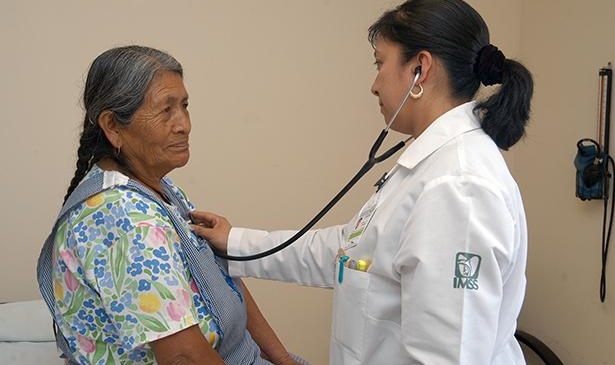Digital Technologies
Throughout Latin America, a digital divide has emerged.
A Daily Publication of The Dialogue
Pan American Health Organization Director Carissa Etienne has called on Latin American governments to increase public spending on their health systems to equal at least 6 percent of gross domestic product. The Covid-19 pandemic has weakened health systems in the Americas, and more investment in them is needed, said Etienne. How much capacity do governments have to increase public spending on health care, and what should funds for the sector be spent on? What innovations in delivering better health outcomes that emerged during the pandemic ought to be expanded and scaled up? What are the economic consequences if governments in Latin America do not significantly increase spending on health care, and what sort of roadmap should countries follow when considering health investments that would bring about a faster economic recovery?
Antonio Vergara, head of Roche Diagnostics Latin America, and Rolf Hoenger, head of Roche Pharma Latin America: “For the last two years, health care has become a major priority for both the public and private sectors in Latin America. While this has been a tremendous opportunity to highlight how smart investment in health can benefit social development and economic growth, access to quality care services continues to be a challenge for a large portion of the population, especially in Latin America, leaving too many patients vulnerable. According to the Pan American Health Organization, to improve the performance of health systems in the region, countries need to increase their investment in health care to at least 6 percent of their GDP and allocate at least 30 percent of that value to primary care services. Not only do efficient care services guarantee people’s well-being and shield our countries against the multi-layered impact of emergencies such as the Covid-19 pandemic, but investments in health have proven to at least double their output in the economy. In short, investments in health can address the physical wellbeing of people while enabling economic growth. In this sense, health investment in the region should accelerate adoption of innovation, creating a more robust digital infrastructure that enables data-driven care models, such as personalized health care. In addition, increased investment in prevention through the expansion of data and technology capabilities enables optimized health care outcomes by better innovating medicine and establishing screening, early diagnosis and monitoring programs. These initiatives would treat diseases faster and more efficiently, leading to better outcomes for patients and more efficient health systems.”
Jarbas Barbosa, assistant director of the Pan American Health Organization: “In the 2014 Universal Health Strategy, countries committed to increase public investment to at least 6 percent of GDP in health with a focus on primary health care. Yet today, only six countries of the Americas have achieved that goal. The Covid-19 pandemic has only amplified the very same inequalities that we set out to address many years ago, further affecting the lives, livelihoods and health of communities throughout the region. The pandemic continues to disrupt the delivery of essential health services in almost all countries in Latin America. As we begin to emerge from this crisis, we must urgently look at ways to increase the region’s investment in the health work force, strengthen the capacity for disease surveillance, expand regional and local medical supply production, strengthen the region’s supply chain infrastructure, capacities and resilience, develop regulatory frameworks for health systems and improve health financing. PAHO’s Regional Platform to Advance the Manufacturing of Covid-19 Vaccines and other Health Technologies in the Americas will be key to ensuring the region’s preparedness and resilience. The pandemic has been a wake-up call for us all and one that we cannot afford to ignore. Without leadership and governance, appropriate investment and vast improvements in the capacity of health systems to detect, respond and mitigate the impact of pandemics and health emergencies, our region will simply not be able to achieve sustainable development.”
Arachu Castro, Samuel Z. Stone Chair of Public Health in Latin America at Tulane University’s School of Public Health and Tropical Medicine: “The Covid-19 pandemic has exposed the limitations of Latin American and Caribbean health systems, the strengthening of which cannot continue to wait or depend exclusively on the budgets allocated during the pandemic. The political instability that preceded the pandemic in countries in which the population demanded more redistributive and fair social policies, together with the devastating impact of the pandemic, create the ideal conditions for governments to justify spending 6 percent of their GDP on health and to fund other social policies—such as cash transfers and other forms of responses to hunger—despite the economic contraction that has resulted from the pandemic. PAHO suggests that 30 percent of this budget be allocated to primary health care. Doing otherwise would not only set back hard-won health and social gains but would exacerbate the consequences of the current crisis and prevent countries from being prepared for the next pandemic or humanitarian crisis.”
Rocío Sáenz, professor in the School of Public Health at the University of Costa Rica and former health minister of Costa Rica: “The pandemic has exposed social inequalities and health systems’ weaknesses for a comprehensive approach to a global crisis. It is necessary to have resources to maintain health programs for children, women, adults and the elderly. In particular, it is important not to interrupt or delay treatment for cancer and chronic diseases as well as diagnostic, therapeutic and rehabilitation procedures, and palliative care. These patients have not had a break from their illnesses during the pandemic. Investment in health is an indicator of the value that societies give to living healthy. However, it has been shown that more money per capita does not necessarily translate into better health for everyone. The sources of financing for universal health systems have been modeled off of charges to public finances with general or specific taxes or on financing models based on contributions from workers, employers and the state. The pandemic has also encouraged wider use of telemedicine and a greater appreciation of digital information and teleworking in health, as well as the establishment of call centers to monitor cases and home delivery of medicines. The search for additional resources for the health sector requires the strengthening of principles such as solidarity, universality and equity, as well as the strengthening of integrated and comprehensive care models involving individuals, families and communities, ensuring the continuity of care.”
Ricardo Izurieta, professor at the College of Public Health at the University of South Florida: “The Covid-19 plague of the 21st century will be recorded in history as one of the most disastrous events affecting the economies of all countries in the world. Even sophisticated health care systems built by high-resource countries were unable to resist the pandemic because of their curative models. Unfortunately, health practice has become one of the best businesses in the world. This commercial health system has understood that intensive care units are more lucrative than primary health care clinics. Global health care systems need to be fixed with the repotentiation of the primary health care infrastructure. Governments and societies need to understand that other variants and plagues are coming, and the world must be prepared for the next ones. Therefore, governments must concentrate and increase their health expenditures in primary health care by improving access to vaccines, health education, water and sanitation infrastructure, early diagnosis and early treatment. What if a new pathogen that is not only airborne but also waterborne, foodborne and vector-borne emerges? Francisella tularensis, the causative agent of tularemia, can be one of those pathogens with a high mortality rate of between 30 and 60 percent. Moreover, this pathogen is considered a Category A biothreat agent and requires a level 3 biocontainment. Are we prepared to face the next plague?”
 The Latin America Advisor features Q&A from leaders in politics, economics, and finance every business day. It is available to members of the Dialogue’s Corporate Program and others by subscription.
The Latin America Advisor features Q&A from leaders in politics, economics, and finance every business day. It is available to members of the Dialogue’s Corporate Program and others by subscription.
Throughout Latin America, a digital divide has emerged.
Government agencies and international organizations race to find a solution given recent information about the link between Zika and neurological disorders.
Iván Duque, a conservative former senator, on Sunday won Colombia’s presidential runoff election. What does it mean for the country?
 File Photo: Mexican Government.
File Photo: Mexican Government.

